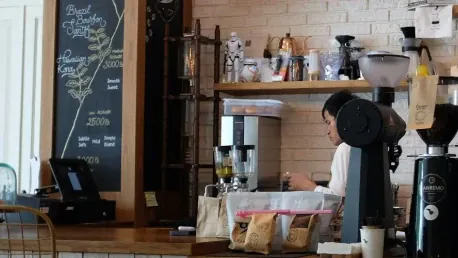In today’s ever-evolving retail landscape, the debate about the future of shopping is intensifying. With the rise of digital platforms and the enduring appeal of physical stores, many retailers are exploring the benefits of an omnichannel approach. Central Food Group, under the leadership of CEO Stephane Coum, stands at the forefront of this movement, showcasing the potential and resilience of combining bricks and clicks in retail. This article delves into the strategic and operational dimensions of Central Food Group’s journey towards an integrated, seamless shopping experience.
The Visionary Leadership of Stephane Coum
Stephane Coum’s appointment as CEO of Central Food Group in 2019 initiated a transformative period for the company. Bringing over 30 years of global retail experience to the table, including senior roles at Carrefour in multiple countries, Coum’s vision centered around unifying the company’s structure and enhancing its digital strategies. His leadership significantly impacted how the company navigated the initial challenges, particularly during the COVID-19 pandemic.
Upon his arrival, Coum prioritized breaking down internal silos to foster a more cohesive organizational culture. This shift proved timely as the pandemic disrupted traditional retail models, emphasizing the need for agility and innovation. Coum’s belief in the lasting value of physical stores—contrary to widespread opinions of their obsolescence—reinforced the company’s dual focus on digital and in-store experiences.
Coum’s experience and leadership were instrumental in steering the company through turbulent times. He leveraged his extensive background to introduce measures that not only fortified the company’s position but also prepared it for future challenges. Under his guidance, Central Food Group has embraced a balanced approach, ensuring that both physical and digital retail experiences are optimized to meet evolving consumer expectations.
Challenges and the Shift Towards Omnichannel
The onset of the COVID-19 pandemic posed unprecedented challenges for Central Food Group. Like many retailers, the company faced a drastic drop in foot traffic and in-store sales, especially exacerbated by the decline in international tourism. Thailand, with a population of over 60 million and an extensive reliance on tourism, saw a significant contraction in retail activity. However, as tourism began to rebound in 2023, so did the company’s in-store sales. This resurgence highlighted the durability of physical retail and emphasized that consumers still valued in-store shopping experiences.
The omnichannel approach that Coum advocated became all the more relevant, integrating online platforms that thrived during the pandemic with the robust performance of brick-and-mortar stores post-pandemic. This strategy not only mitigated the impact of reduced physical traffic during lockdowns but also positioned Central Food Group as a versatile and resilient player in the retail market. The ability to pivot rapidly and adapt to consumer needs across various channels underscored the company’s agility and foresight in embracing omnichannel retail.
In addition to navigating these immediate challenges, Coum focused on reinforcing the digital domain of the company. Initiatives were put in place to ensure that the company’s online platforms could handle increased demand and offer a seamless experience akin to their physical counterparts. This dual focus ensured that Central Food Group could cater to the needs of consumers irrespective of how they chose to shop. The lessons learned during the pandemic highlighted the importance of flexibility and the need for an integrated approach to retail.
The Structure and Strength of Physical Stores
At the heart of Central Food Group’s business model is a well-defined cluster of physical stores, each catering to different market segments. The high-end Tops Food Hall, aimed at premium shoppers, accounts for a significant portion of total sales with its expansive, diverse offerings. Tops Supermarket, the flagship brand, dominates the Thai supermarket sector with a 40 percent market share, focusing on both upper and mass premium markets through its extensive network of around 160 stores.
Expanding on this, Tops Premium offers an even broader range of high-quality, imported goods to meet the sophisticated tastes of consumers. Finally, the Tops Daily brand conversion from FamilyMart convenience stores adds another layer of accessibility and convenience with over 500 outlets nationwide. This strategic segmentation allows Central Food Group to cater to a wide array of customers, ensuring that various needs and preferences are met across different store formats.
These physical stores represent more than just shopping venues; they are crucial touchpoints for the brand, offering distinct experiences that foster customer loyalty. The meticulous organization into these clusters ensures that each store type is tailored to its target demographic, thus optimizing customer satisfaction. This physical presence not only reinforces brand identity but also enables the company to offer services that are difficult to replicate online, such as personalized customer service and immediate product availability.
The resilience of these physical stores was particularly evident as tourism rebounded. By maintaining a robust network of stores, Central Food Group could quickly capitalize on the increased foot traffic and meet the needs of both local and international customers. The strategic placement and operational efficiency of these stores ensured that the company could achieve high sales volumes and sustain its market-leading position in the face of fluctuating external conditions.
The Omnichannel Evolution
Embracing an omnichannel strategy has been central to Coum’s leadership. Central Food Group’s approach spans four essential segments. Firstly, Tops Online, the company’s dedicated online shopping platform, experienced substantial growth over the past six years. Coum also leveraged partnerships with Quick Commerce platforms like Grab and Foodpanda to provide swift delivery services. This holistic integration not only expanded the company’s reach but also ensured that customers could shop in the way that best suited their needs.
Moreover, the integration with third-party marketplaces such as Lazada, Shopee, and TikTok expanded the company’s online presence, making Central Food Group’s products more accessible. The innovative Personal Shopper Service, featuring 500 associates who assist customers with personalized shopping experiences, further strengthens the omnichannel approach. This service underscores the seamless combination of digital and physical interactions, enhancing customer loyalty and satisfaction.
The omnichannel strategy has proven to be more than just a temporary adaptation; it has become a cornerstone of the company’s operations. By offering a unified shopping experience across various platforms, Central Food Group has managed to bridge the gap between online and offline retail effectively. This approach ensures that customers enjoy a consistent and engaging experience, whether they choose to shop in-store, online, or through mobile platforms.
The success of the omnichannel strategy is evident in its contribution to the company’s overall sales. Accounting for 10 percent of Central Food Group’s revenue, the omnichannel segment highlights the increasing importance of this integrated approach. Coum’s vision of a seamless retail experience is not just about leveraging technology but also about understanding and meeting consumer preferences. The strategic blend of convenience, personalization, and accessibility has positioned Central Food Group as a leader in the omnichannel retail revolution.
Expansion Plans and Market Adaptation
Looking towards future growth, Central Food Group is set on expanding its footprint, particularly focusing on enhancing its brick-and-mortar presence. The company plans to open approximately ten new supermarkets annually over the next five years, with a strategic focus on Thailand’s top six cities. Additionally, the Tops Daily format is poised for rapid expansion, with 30 to 35 new outlets expected each year post-2024. This aggressive expansion strategy underscores the company’s commitment to strengthening its physical retail network.
Acknowledging the economic challenges and cost-of-living concerns, the company has adapted by implementing initiatives like the price-lock campaign, ensuring essential items remain affordable for consumers. The growing emphasis on private label products, now constituting over 11 percent of sales, reflects this adaptive strategy. Central Food Group’s My Choice brand exemplifies commitment to quality and affordability, crucial factors driving consumer trust and loyalty.
These expansion and adaptation plans are not just reactive measures but part of a forward-thinking strategy. By continuously innovating and focusing on customer needs, Central Food Group ensures that it remains relevant and competitive in a dynamic market. The emphasis on affordability and quality, particularly through private label products, helps the company cater to a broader audience without compromising on its premium positioning.
The planned expansion is also a testament to the company’s confidence in the future of physical retail. By establishing new stores in strategic locations, Central Food Group aims to enhance its market presence and accessibility. This growth trajectory is aligned with Coum’s vision of a balanced retail ecosystem where bricks and clicks coexist harmoniously. The consistent focus on consumer needs reinforces the company’s position as a leader in the Thai retail market.
Commitment to Quality and Sustainability
In today’s evolving retail environment, the debate over the future of shopping is heating up. With the surge in digital platforms alongside the lasting appeal of brick-and-mortar stores, many retailers are recognizing the advantages of an omnichannel approach. Central Food Group, led by CEO Stephane Coum, exemplifies how to successfully blend online and offline retail channels. Under Coum’s guidance, the company is demonstrating the potential and resilience of combining bricks and clicks in the retail sector. This strategy not only addresses changing consumer preferences but also ensures a seamless and integrated shopping experience.
This article explores the strategic and operational aspects of Central Food Group’s journey. By examining how they merge the digital and physical aspects of retail, we gain insights into their comprehensive approach. The company’s innovative tactics, such as utilizing technology to enhance customer engagement and optimizing supply chain logistics, highlight the future direction of retail. Central Food Group’s commitment to creating a unified shopping experience is a testament to their forward-thinking and adaptability in a competitive retail landscape. As the retail industry continues to transform, Central Food Group stands as a model of how to effectively navigate and excel in both the digital and physical realms.









